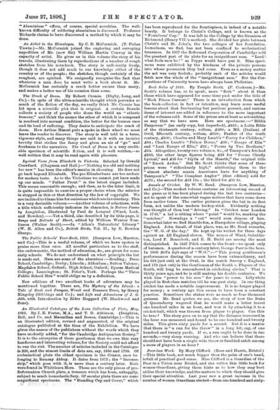Annals of Cricket. By W. W. Read. (Sampson Low, Marston,
and Co.)—This modest volume contains an interesting record of the game as it has been played during the last two centuries— not to speak of the somewhat vague notices that have come down from earlier times. The earlier pictures gives the bat in its first form, not unlike the modern hockey-stick. Evidently nothing was thought of then but " driving." In " Cricket near London in 1743," a lad is sitting where " point " would be, marking the "notches." Nowadays a " cut " would soon dispose of him. Somewhat later we find Hambledon, a Hampshire village, playing England. John Small, of that place, was, as Mr. Read remarks, the " W. G. of the day." He kept up his wicket for three days against an All England eleven. The names of Ward, Osbaldis- ton, Lord F. Beauclerk, and E. H. Budd are among the most distinguished. In 1827 Pilch comes to the front—we speak only of batsmen. A quarter-of-a-century later, George Parr is the hero. In 1868 Bell's Life says of " W.G." :—" This young gentleman's performances during the season have been extraordinary, and his 224 (not out) at the Oval, in the match Surrey v. England, and 173 (not out) in the Gentleman of the South v. Players of the South, will long be remembered in cricketing circles." That is thirty years ago, and he is still making his double centuries. We wish him "power to his arm" for years to come. Lilly white played in first-class matches till he was past sixty. in one thing cricket has made a notable improvement. It is no longer played for money ; a century ago this seems to have been a constant practice. Sometimes the stakes were as much as four thousand guineas. Mr. Read quotes, we see, the story of how the Duke of Queensberry wagered that he would make a letter travel one hundred miles in an hour, and won it by attaching it to a cricket-ball, which was thrown from player to player. Can this be true ? The story goes on to say that the distance traversed in the hour was measured and found to be one hundred and twenty miles. This gives sixty yards for a second. But it is a maxim that there is " a run for the throw" in a long bit, say, of one hundred and twenty yards. If so, a run ought to be done in two seconds,—very sharp running. And who can believe that there should not have been a single wide throw or fumbled catch among a score of players in an hour ?
















































 Previous page
Previous page